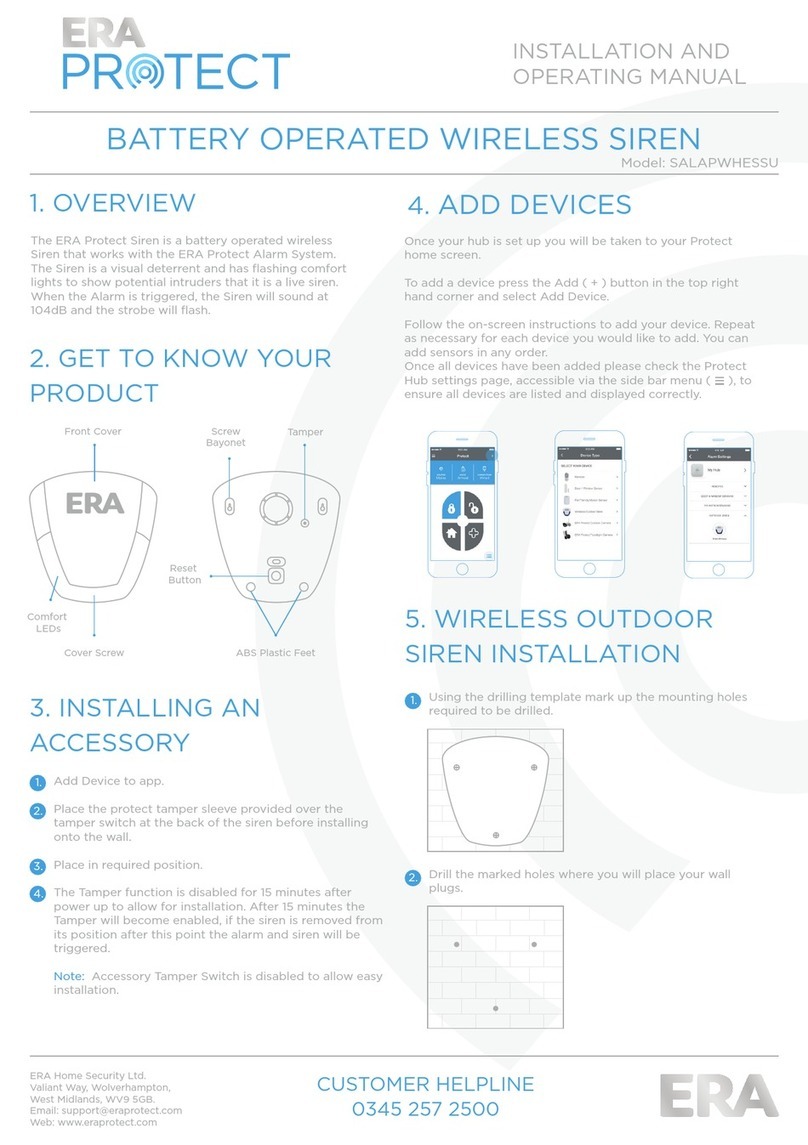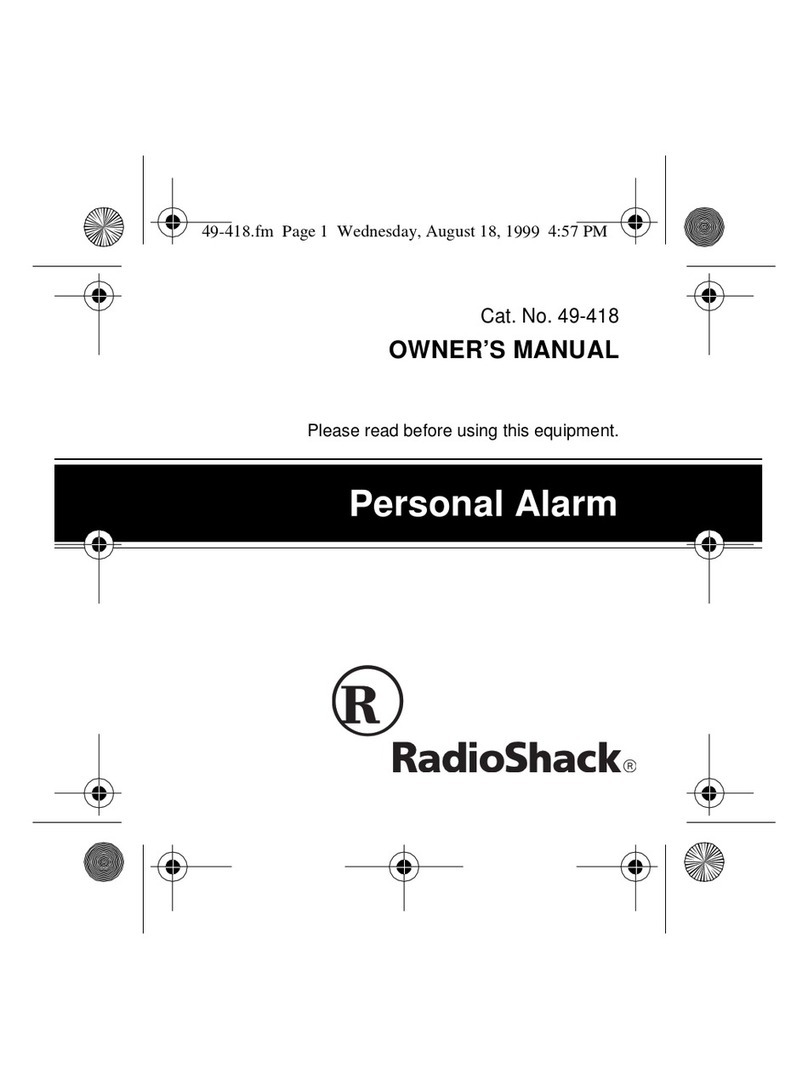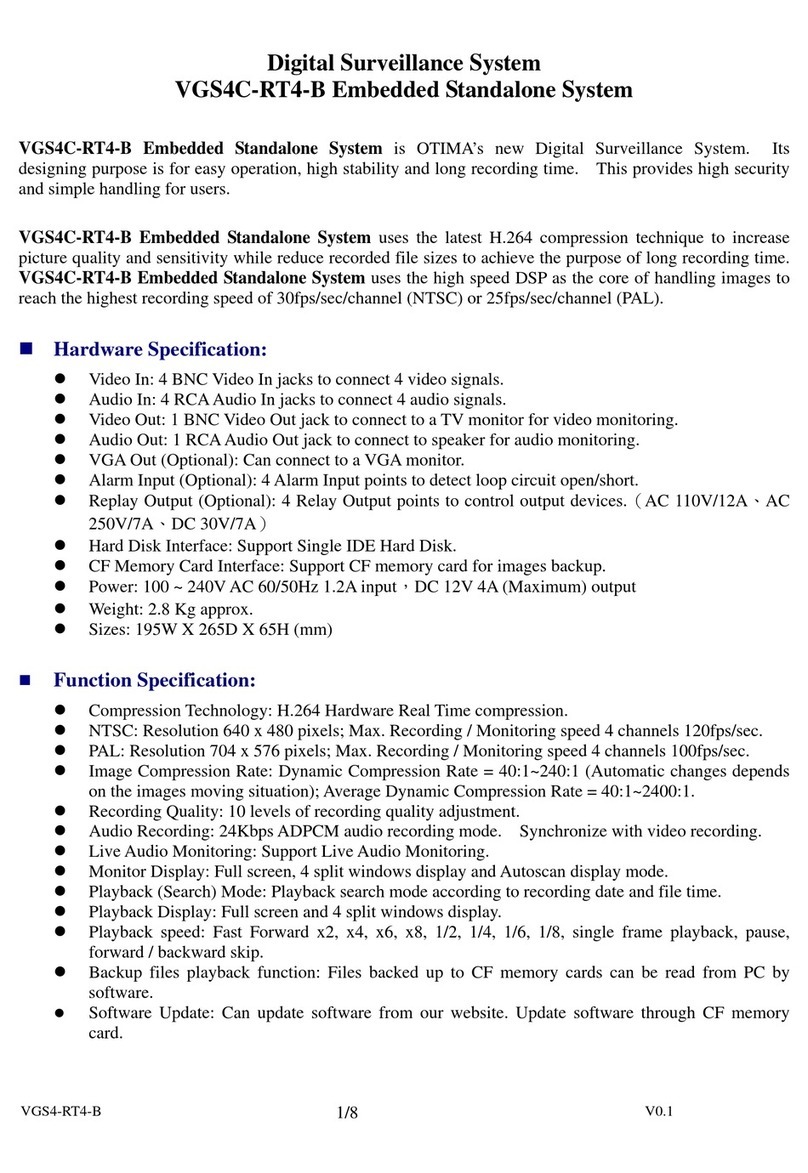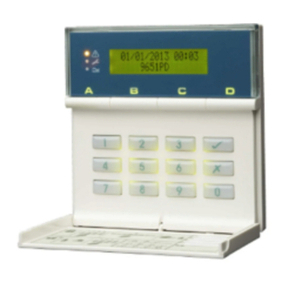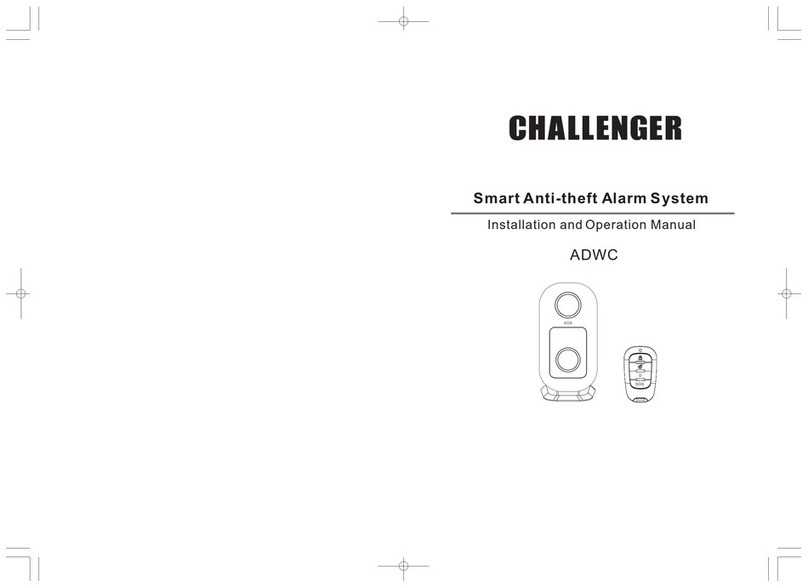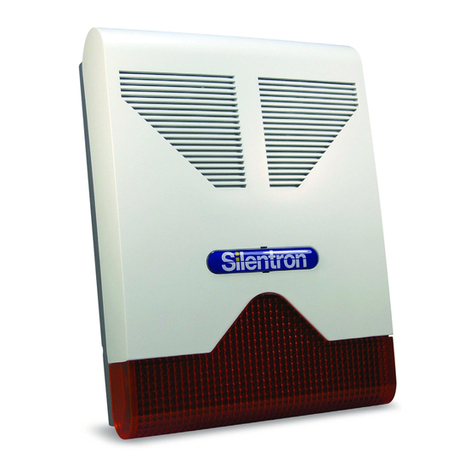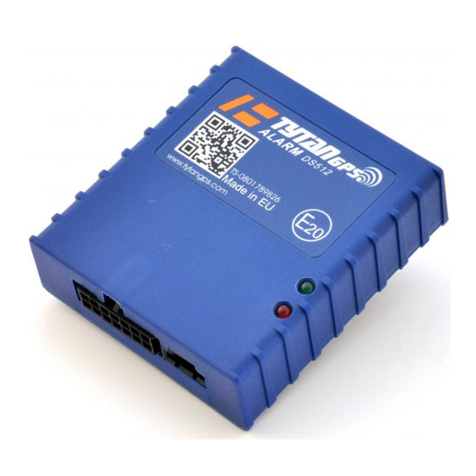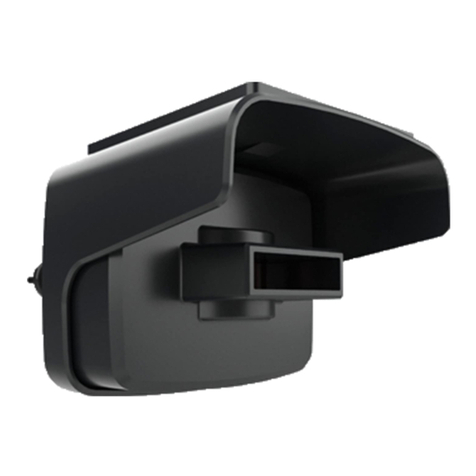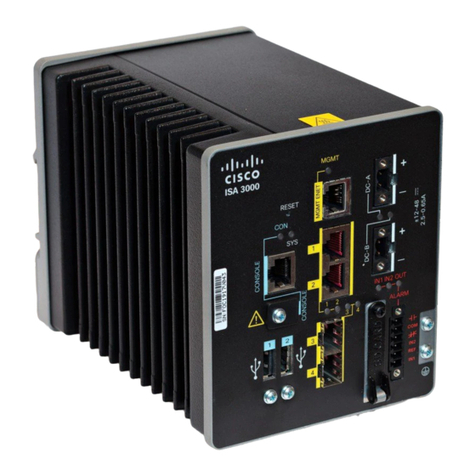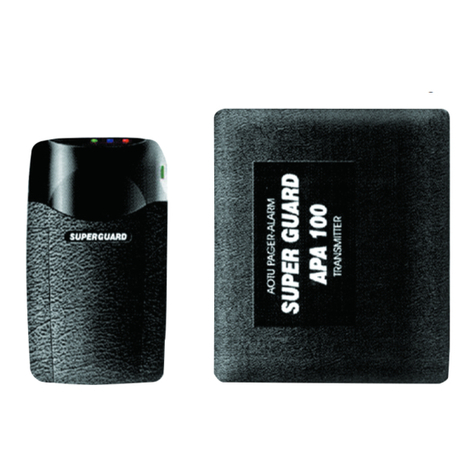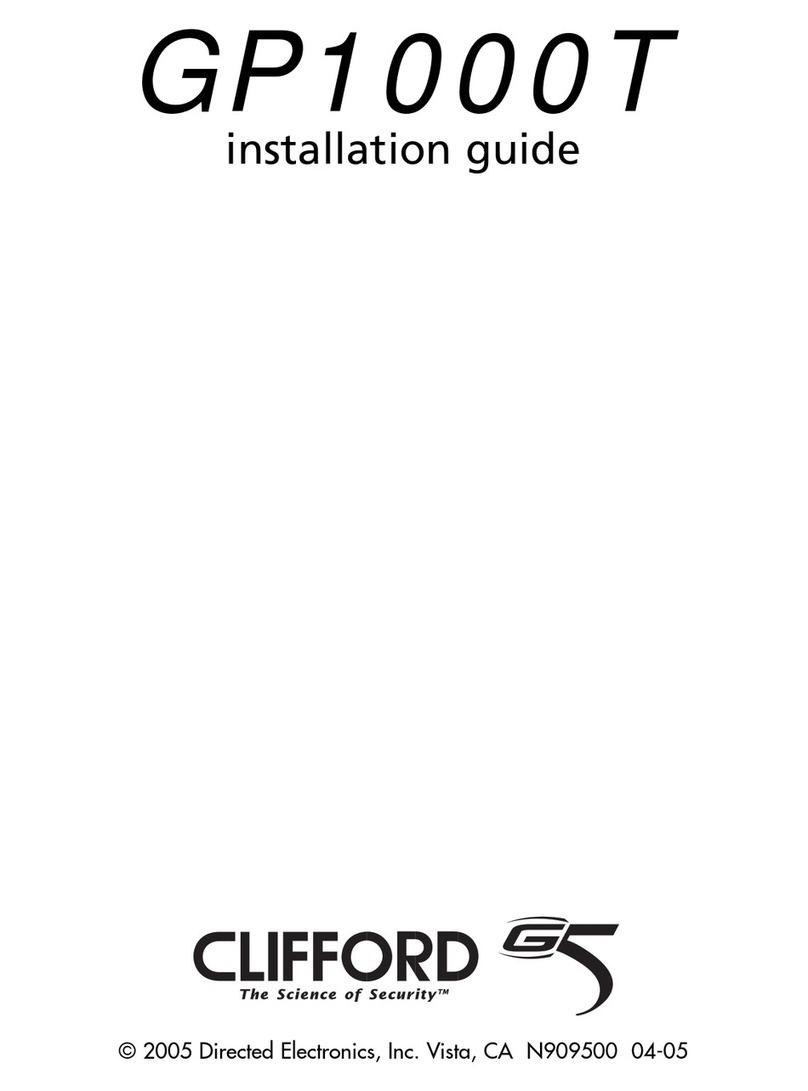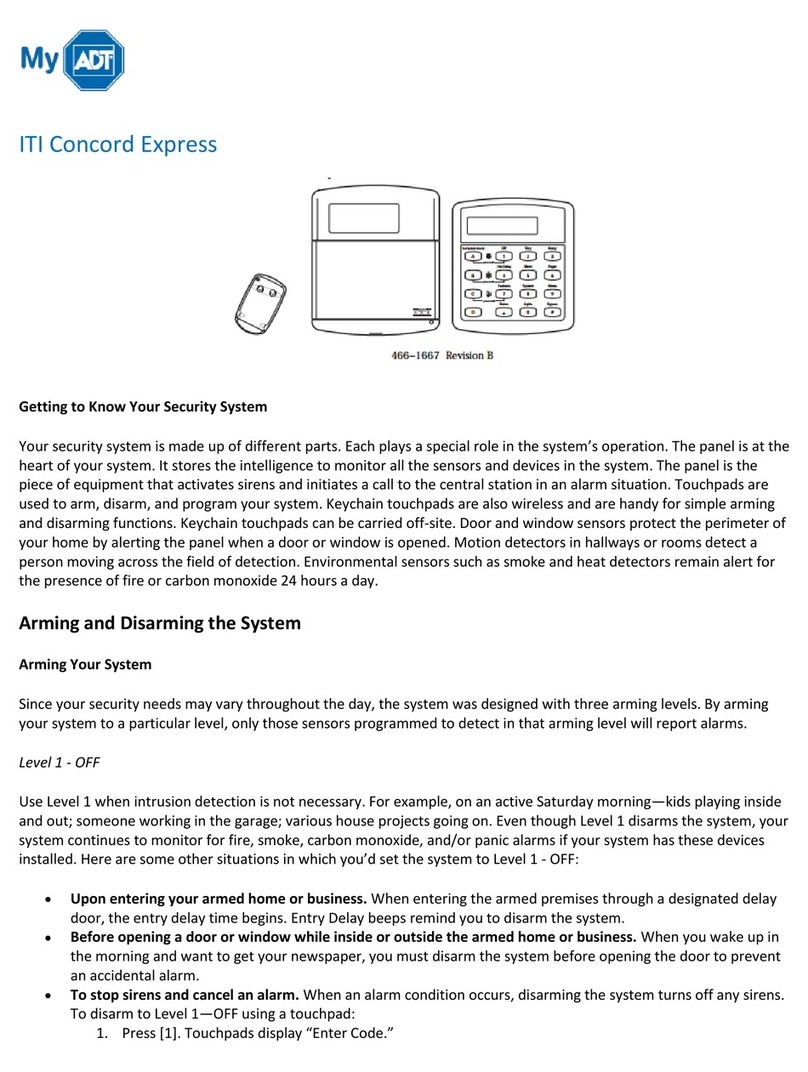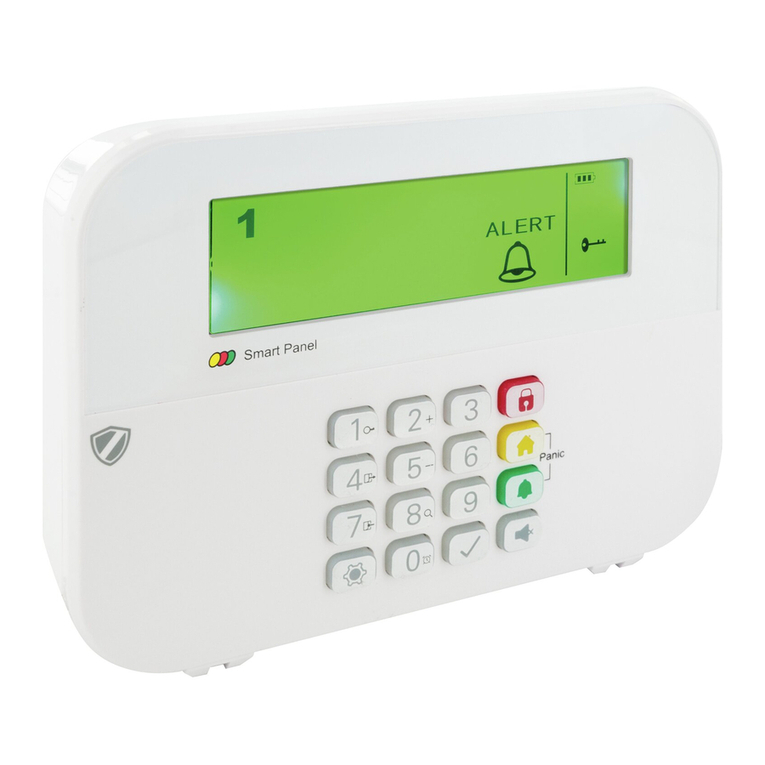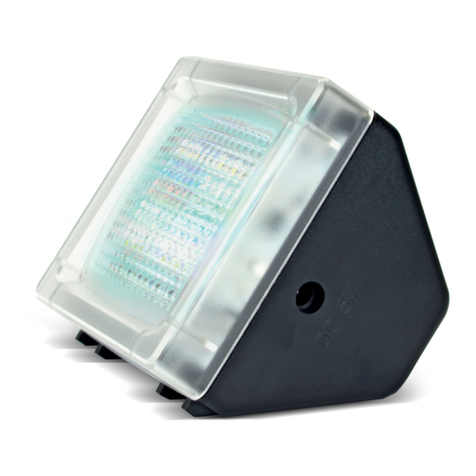New Cosmos Electric ML-310 User manual

Natural Gas Alarm
ML-310
User’s Manual
Thank you for purchasing a New Cosmos USA Natural Gas
Alarm. Please throroughly read and understand this user
manual before using this alarm and retain for future
reference. When methane (natural gas) is detected, an
alarm will be activated. The alarm consists of a flashing red
LED light, sounding of a warning alarm and a recorded
message.
DANGER: ASPHYXIATION & EXPLOSION
NATURAL GAS LEAK ALARM INDICATES AN
EMERGENCY SITUATION AND RISK OF
EXPLOSION
•
Leave building immediately, open doors and
windows as you leave. Take others with you. If
you are outside when you hear the alarm, leave
the area immediately.
•
Avoid creating any sparks.
•
Find a phone AWAY FROM THE AREA and
immediately call 911 and/or your gas utility.
•
Do not re-enter the area until source of the leak
is found and corrected.
Follow directions from utility employees or
emergency responders on site.
DANGER: ELECTROCUTION
•
Do not subject the gas alarm to water or liquid
by submerging it, spraying liquid on it or
otherwise.
•
Do not disassemble.
DANGER: EXPLOSION
Do not use as a short-term testing device. Doing
so may cause explosion.
DANGER: FIRE & EXPLOSION
Improper disposal may result in fire or explosion.
DANGER: HAZARDOUS CONDITIONS
Follow these instructions completely. Failure to do
so may result in an undetected natural gas leak or
other hazardous conditions that may cause
serious injury or death.
DANGER: HEARING DAMAGE
Do not place ear directly against or in close
proximity to gas alarm. Audible alarm may damage
hearing.
WARNING
•
Do not block, cover, obstruct or paint over sensor.
The gas alarm can only detect natural gas that
reaches its sensor.
•
This gas alarm will reach the end-of-service life in
approximately 6 years. Replace after end-of-service
life signal is initiated.
•
Test product regularly. Device must be turned on
and connected to power at all times.
•
Do not modify, disassemble, submerge, strike,
crush, or expose gas alarm to high levels of volatile
organic compounds. May cause gas alarm
malfunction.
•
Contact manufacturer for replacement battery.
Commercially available batteries will not work.
•
Keep out of reach of children.
•
For indoor use only.
NOTICE
•
Gas alarm only detects natural gas. It does not
detect carbon monoxide, fire, heat, smoke, flames,
propane or any other gas.
•
Gas alarm is not a substitute for proper installation,
use, and maintenance of natural gas sources. Gas
alarm does not prevent natural gas leaks from
occurring, nor can it solve any existing natural gas
problems.
General description & intended use
DANGER
If you smell natural gas, evacuate the area right
away, then call 911 or your gas utility. Do not wait
for alarm to sound.
DANGER
This gas alarm is designed to act as a continuous
monitor of natural gas that reaches the sensor.
This gas alarm should not be used as a short-term
testing device to perform a onetime check for the
presence of natural gas, as starting the device in
the presence of natural gas may cause an
explosion.
This gas alarm detects natural gas. Natural gas is a fossil
fuel that is primarily made up of methane. It is commonly
used for cooking, home heating and water heating. Natural
gas is typically supplied through a main utility line
connected to your home. It is a highly flammable chemical
compound. Although it happens rarely, a natural gas leak
can sometimes occur inside the home. This can be
dangerous because it increases the risk of explosion and
fire.
Natural gas is typically odorless and colorless, unless your
supplier treats it with a chemical to make it smell.
Individuals with diminished sense of smell may not be able
to detect even treated natural gas. If you are not sure which
gas your home uses, contact your utility company.
When this product detects natural gas at a concentration of
greater than or equal to 10% LEL for methane, it is
designed to beep 4 times and state “Danger – gas leak
explosion risk –evacuate, then call 911.”
It is possible that you may smell natural gas before the
alarm is activated. If you do smell natural gas, do not wait
for the alarm to sound. Evacuate right away, then call 911.

This gas alarm is designed to act as a continuous monitor
of natural gas that reaches the sensor. This gas alarm
should not be used as a short-term testing device to
perform a onetime check for the presence of natural gas, as
starting the device in the presence of natural gas may
cause an explosion.
Gas Alarm parts
Installing the Gas Alarm
Selecting gas alarm location
WARNING
•
Installation in an improper location can affect
the sensitive electronic components in this
device.
•
Improper placement can prevent detection of
natural gas.
•
Improper placement can prevent you from
hearing the alarm. Install in a location where you
can hear the alarm sound loudly from all
sleeping areas.
•
Place out of reach of children. Under no
circumstances should children be allowed to
handle this device.
Gas alarms should be installed in all rooms where a gas
leak may occur or a gas appliance is located. Examples are
a kitchen (gas leaks from gas ovens and cook tops),
laundry (gas leaks from a gas clothes dryer), and furnace
area (gas leaks from furnace burners or boilers).
It is possible that gas leaks may migrate along pipes so
consideration should be given to place gas alarms in
multiple rooms. Consider placing a gas alarm in each
bedroom where the occupant closes the door while
sleeping.
Although it is important to install gas alarms in rooms
were gas appliances exist, it is recommended the gas alarm
be placed as far from these appliances as possible,
preferably more than 10 feet (3 meters) away. The
placement recommendations are intended to keep these
gas alarms at a reasonable distance from a gas source, and
thus reduce “unwanted” alarms, which can occur if a gas
alarm is placed directly next to a gas source.
Avoid placing the gas alarm near a cooking appliance or
cooktop hood. If you must do so, install at least 5 feet (1.5
meters) from cooking appliance or cooktop hood because
cooking vapors or grease may contaminate the gas alarm.
Product should be installed:
•Between 4 to 12 inches (0.1 to 0.3 meters) from the
ceiling.
•In an area where it will not be impeded by items
hanging from or near the ceiling such as curtains,
drapes, ceiling fans.
•At least 5 feet (1.5 meters) from cooking appliance or
cooktop hood.
•At least 10 feet (3 meters) from gas appliances.
Product should NOT be installed:
•In the peak of a cathedral ceiling.
•Directly above or near sources of water or humidity
such as a sink, cooktop, dishwasher or shower.
•Next to a door or window.
•Next to a ventilation fan.
•Near a room return or HVAC duct.
•In an area where the temperature will drop below 32°F
(0°C) or exceed 122°F (50°C).
•In an area that is dusty or dirty.
•In an area where organic solvents exist.
•In a damp or very humid location, such as a bathroom.
•Outside.
Installing (or replacing) the battery
DANGER –SHOCK
Do NOT remove the plastic wrap surrounding the
battery pack. Doing so may cause electrical short
or shock.
WARNING
After installing or replacing battery, always test
the gas alarm to ensure it is operational.
NOTICE
Device uses type of battery that is not available in
retail. Contact manufacturer for replacement
batteries.
To install the included battery or replace with
manufacturer-supplied replacement:
•Open the battery cover on the back of the gas alarm.
This cover slides out of place. To open, place both
thumbs on the back of the battery cover where the
battery cover hooks snap into place.
•Push down where the battery cover snaps into place
with your thumbs and slide the cover out. Some force is
required.
•Connect the included lithium battery by inserting the
battery harness connector into the gas alarm as shown
in the diagram below. Do NOT remove the plastic wrap
surrounding the battery pack.

•The battery connector has a large notch on it that faces
up when installed correctly. There is only one way in
which the connector can be installed. A small portion of
the connector will be exposed when connected properly.
If replacing battery, see “Disposal” section for instructions
on disposing of the old battery.
Mounting the gas alarm
NOTICE
After mounting the gas alarm, test it following
instructions in User Guide.
The gas alarm may be mounted to a pipe or wall in a
location meeting the criteria discussed in the “Selecting
gas alarm location” section.
To mount to a pipe:
(1) Pass a cable tie through the hole at the top of the
gas alarm. Cable tie is not included with device
purchase.
(2) Wrap the cable tie around the pipe and tie off.
To mount the gas alarm to a wall:
(1) Tools you will need: Drill with 3/16” or 5mm drill bit,
Phillips head screwdriver, hammer.
(2) Tools supplied: A plastic screw anchor and screw
have been provided in the box and can be found
under the battery packaging.
(3) Choose a location on the wall between 4 inches
(0.1 meters) to 12 inches (0.3 meters) from the
ceiling. Make a mark in the Mounting Tab of the gas
alarm where you will drill the mounting hole.
(4) Use a 3/16” (5 mm) drill bit to drill the mounting hole
and insert included anchor.
(5) Tighten the screw into the anchor until the
screwhead is about 3/16”inch (5 mm) away from
the wall, leaving enough space for the Mounting
Tab.
(6) Hang the Mounting Tab on the screw.
(7) Lightly tighten the screw to secure the gas alarm.
Gas alarm functions
The gas alarm is designed to activate an alarm in the event
of a natural gas leak, gas alarm error, low battery or end-of-
service-life for the gas alarm.
Natural gas leak alarm activation
An alarm activates when the concentration of natural gas in
the area of the gas alarm reaches or exceeds 10%LEL for
methane. When activated, alarm is designed to:
Beep 4 times and state “Danger – gas leakexplosion risk –
evacuate, then call 911.” Notification will repeat every 6
seconds for 4 minutes, then every 1 minute after.
Red LED flashes once every 2 seconds.
Responding to natural gas leak alarm
activation
DANGER–ASPHYXIATION & EXPLOSION
Follow these instructions carefully in the event
that the natural leak alarm activates. Never ignore
natural gas leak alarm.
When this product detects natural gas at a concentration of
greater than or equal to 10% LEL for methane, it is
designed to beep 4 times and state, “Danger – gas leak
explosion risk –evacuate, then call 911.” A red LED light
will also flash on the product.
Leave the building immediately, opening doors and
windows as you leave. Take others with you. If you are
outside when you hear the alarm, leave the area
immediately.
Any spark might cause natural gas to explode. Take all
appropriate steps to avoid causing a spark near the
affected property, including the following:
•
Do not remove the connector from the lithium battery
•
Do not light a match or smoke.
•
Do not turn appliances or lights on or off.
•
Do not use a flashlight or phone.
•
Do not start a car.
Find a phone away from the area and immediately call
911 and/or your natural gas utility. You can report leaks
anonymously.
Do not re-enter the area until the source of the leak is
found and corrected. Follow directions from utility
employees or emergency responders who are on site.

DANGER: EXPLOSION RISK
Do not reset gas alarm after gas leak alarm goes
off, unless instructed to do so by emergency
personnel. Resetting process can cause an
explosion if conducted in an area with high
concentrations of natural gas.
Emergency responders or trained personnel may reset or
instruct you to reset the Gas Alarm by removing and
reinstalling the battery. After removing the battery, hold the
test button for at least 10 seconds and leave the battery
unplugged for at least 2 minutes. This will reset the device
by turning off auditory and visual notifications.
Gas alarm error activation
An alarm sounds when a device error occurs.
Will sound every 60 seconds, beep 3 times and state
“Danger – detector error.”
Yellow LED flashes 3 times every 10 seconds
See “Troubleshooting” section for more information on
resolving device errors. See “Installing (or replacing) the
battery” section.
Low battery alarm activation
WARNING
Gas alarm uses specialized battery not available
at retail. Contact New Cosmos USA, Inc. for
replacement.
An alarm sounds when the battery is low. Alarm will sound
every 60 seconds, beep 1 time and state “low battery.”
Yellow LED flashes once every 10 seconds
Contact New Cosmos USA for replacement battery.
End of service life alarm activation
An alarm activates when the end of service life is reached.
Alarm will sound every 60 seconds. beep 2 times and state
“Please replace detector.”
Yellow LED flashes 2 times every 10 seconds.
Testing the gas alarm
CAUTION
Test your gas alarm’s power and gas leak alarm
notifications at least once a week.
If the device does not operate properly it cannot
alert you to the presence of natural gas. Take
immediate action if your gas alarm fails a test.
Testing power
Press test button until you hear a “Beep” sound, then
quickly release (within 3 seconds from when the button was
pressed). If the device is properly powered, the green LED
will flash twice every second (for 3 seconds) to indicate that
the power is on.
Testing gas leak alarm notifications
Press test button for more than 3 seconds and release to
test the gas leak alarm notification. Alternatively, hold down
the test button for 5 seconds and the alarm notification test
will begin automatically.
If the device is operating properly, the red LED will flash
once every 2 seconds for a 12 second period, and the
following alarm message will sound twice: “Beep Beep
Beep Beep Danger –gas leak explosion risk –evacuate,
then call 911.”
Cleaning
WARNING
Clean the gas alarm in accordance with these
instructions once a month. Dirt and dust can
cause gas alarm malfunction.
After cleaning, always test the gas alarm to
ensure it has not been damaged.
Clean at least once a month to maintain proper operation,
by vacuuming the exterior of the gas alarm using a

household vacuum's soft brush attachment.
Never use water, cleaners or solvents since they may
damage the unit.
Do not use spray cleaning chemicals or insect sprays
directly on or near the device. Do not use any
household cleaning agents, ammonia-based
cleaners, paints, varnishes, aerosol sprays (including
compressed gas dusters), or any other chemical on or
near this device.
Troubleshooting
Symptom
Cause
Action
The green LED
does not flash
even when the
switch is
pressed
Battery connector not
plugged in
Plug in the battery
connector
Battery is low
Contact
manufacturer for
replacement
The yellow LED
is flashing.
Flashes three times
every 10 seconds:
Gas alarm trouble
Replace gas
alarm
Flashes twice every 10
seconds:
End of gas alarm
service life
Replace gas
alarm
Flashes once every 10
seconds:
Low gas alarm battery
Contact
manufacturer for
replacement
Disposal
DANGER
Prior to disposing of product, remove and wrap
the removed battery with tape or similar material
to avoid potential explosion or ignition that may
result in injury or fire.
DANGER
Do not incinerate. Battery may explode.
When disposing of product, remove the battery and wrap
with tape or similar, non-flammable material.
Dispose of battery in accordance with local regulations
relating to non-rechargeable (single use) lithium batteries.
Dispose of remainder of device following your local
regulations for solid waste disposal. Take the device to an
electronics recycling facility (where such facilities exist) for
disposal.
Specifications
Model number
ML-310
Conforming standards
UL standard (UL1484)
Detection principle
MEMS hot wire semiconductor sensor
Target gas
Methane gas (Natural Gas)
Operating temperature
range
32°F (0°C) to 122°F (50°C)
Operating humidity
range
5% to 95%, no condensation
Power supply
3V Lithium battery
Alarm level
10% LEL*
Speaker output
Gas alarm: 85 dB at 10 feet
Battery lifetime
Approximately 6 years
Dimensions
W 85 × H 110 × D 22 mm
Installation
Pipe mount by cable ties or wall mount
with hardware.
*LEL, short for “Lower Explosive Limit”, is defined as the lowest
concentration (by percentage) of a gas or vapor in air that is capable of
producing a flash of fire in presence of an ignition source (arc, flame,
heat).
Contact Details
New Cosmos USA, Inc.
650 Warrenville Rd, Suite 101
Lisle, IL, 60532
Phone: (847) –749 –3064
Other manuals for ML-310
1
Table of contents
Other New Cosmos Electric Security System manuals


